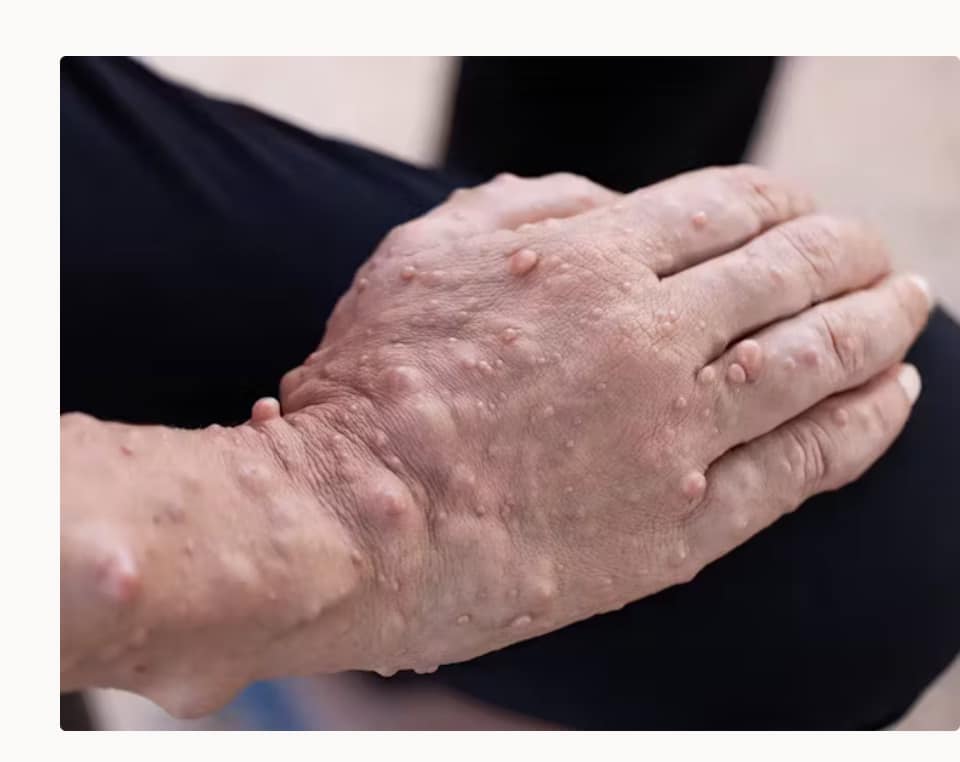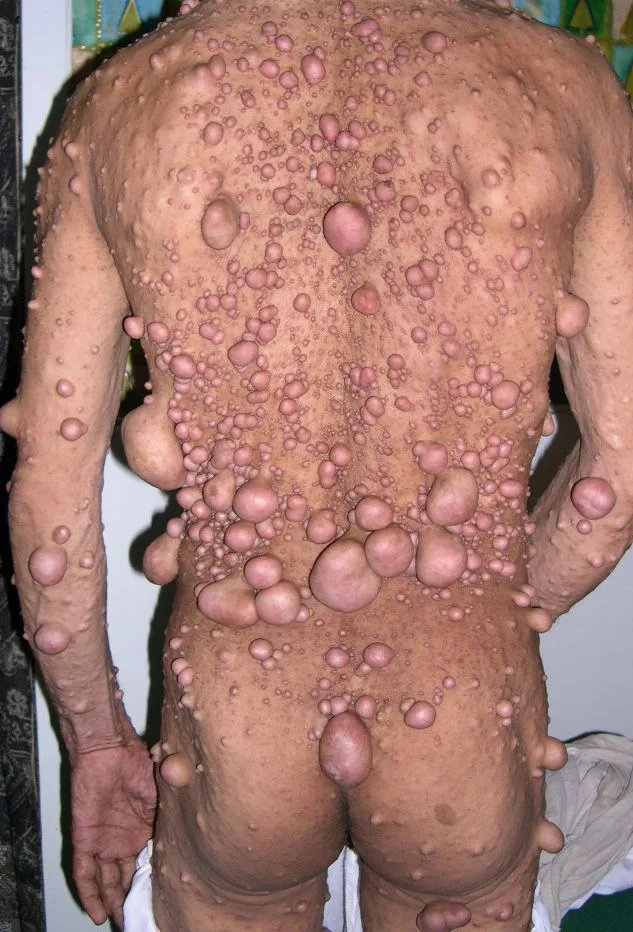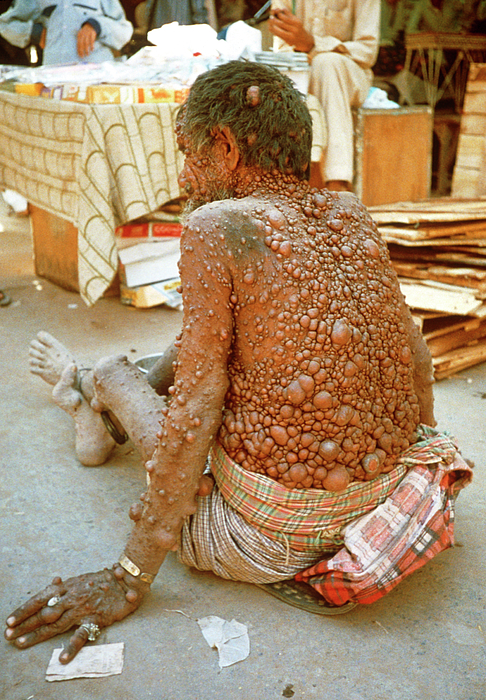Cudurka ka muuqda qofkan wuxuu u eg yahay xaalad caafimaad oo loo yaqaan Neurofibromatosis (NF). Waa cudur hiddo-side ah oo sababa in lafo-xanuunyo iyo burooyin fibroos ah ay ka soo baxaan maqaarka iyo unugyada gudaha ee dareenka. Waxaa jira saddex nooc oo waaweyn oo Neurofibromatosis ah:

- NF1: Waxaa lagu gartaa burooyin maqaarka ka soo baxa, dhibco bunni ah oo la yiraahdo “café-au-lait,” iyo dhibaatooyin dareenka ah.
- NF2: Badanaa waxay saameysaa dareemayaasha maqalka, iyadoo lagu garto burooyin ku yaalla dareemayaasha maskaxda.
- Schwannomatosis: Waa nooc ka duwan oo ku badan burooyinka dareemayaasha.
DAAWADA
Neurofibromatosis ma laha daawo buuxda oo cudurka ka saarta maadaama uu yahay cudur hidde-side ah, laakiin waxaa jira siyaabo lagu maareeyo astaamaha iyo dhibaatooyinka uu sababo. Daweyntu waxay ku xiran tahay heerka iyo nooca cudurka. Waxay ka koobnaan kartaa:
- Qalliinka (Surgery):
Waxaa loo isticmaalaa in lagu saaro burooyinka waaweyn ee dhibaatooyin muuqaal, dareen, ama xanuun sababa.
Haddii burooyinka ay saameeyaan dareemayaasha muhiimka ah (sida maqalka), qalliinka waa lagama maarmaan.

- Daaweynta Raajooyinka (Radiation Therapy):
Waxaa loo isticmaalaa in lagu yareeyo burooyinka qaarkood, gaar ahaan kuwa halis ku ah unugyada maskaxda ama laf-dhabarka.
- Daawada Qoraalka (Medication):
Pain relievers: Loogu talagalay in lagu maareeyo xanuunka.
Daawooyin ka hortagga burooyinka koritaankooda (tusaale, selumetinib oo loo isticmaalo NF1).
Haddii ay jiraan infekshanno la socda, antibiyootiko ayaa loo isticmaali karaa.
- Daaweynta Daawada Molecularka ah:
Waxaa jira daawooyin cusub oo loogu talagalay in lagu joojiyo horumarka burooyinka. Tusaale ahaan, MEK inhibitors sida selumetinib oo la xaqiijiyay inay waxtar leedahay NF1-ga.
- La-talin iyo Daaweynta Nafsiyeed:
Maadaama cudurku saameyn ku yeesho muuqaalka qofka, latalinta cilminafsiga iyo taageerada bulshada aad bay muhiim u yihiin.
- Kormeer Joogto ah:
Dhakhaatiirta ku takhasustay cudurrada hidde-side ah, maqaarka, ama dareenka ayaa si joogto ah u raaci kara cudurka si looga hortago dhibaatooyinka hor leh.

8 Tips for Managing Neurofibromatosis Type 3 (Schwannomatosis
Neurofibromatosis Type 3, also known as Schwannomatosis, is a rare genetic disorder that affects individuals of all ages. Schwannomas are specialized cells that cause the growth of tumors along the nerves and can cause nerve pain and other symptoms. Managing this type of tumor requires careful monitoring and treatment from a medical professional.
Individuals with Schwannomatosis may need to take medications to reduce nerve pain or undergo surgery to remove the tumors. Other forms of Neurofibromatosis, such as Types 1 and 2, have different symptoms and require different treatments. It is important for individuals with Schwannomatosis to be aware of their condition and seek out appropriate medical care in order to manage their symptoms effectively.

- Learn About Neurofibromatosis Type 3
Learning about Neurofibromatosis Type 3 is the first step in managing this condition. It is important to understand the symptoms and how it is diagnosed. Vestibular schwannomas are benign tumors that can form along the nerves of individuals with Schwannomatosis. Genetic testing can be used to determine if an individual has a family history of Neurofibromatosis Type 3, which may help with an accurate diagnosis.
It is important to stay informed about Neurofibromatosis Type 3 to make informed decisions about your health care. Talk to your doctor or specialist about any questions or concerns you may have regarding your condition and treatment options. - Stay Informed About Treatments
You should be able to understand the different types of treatments available and how they can help manage symptoms. Medications such as anticonvulsants, antidepressants, and pain relievers may be prescribed to reduce nerve pain or other symptoms associated with signs of Schwannomatosis. Surgical removal of the tumors is often necessary to reduce pain and other symptoms. During neurofibromatosis surgery, the doctor will perform an examination of the tumor tissue to determine if it is benign or malignant.
It is important to discuss all treatment options with your doctor in order to make an informed decision about which option is best for you. Additionally, it is important to stay up-to-date on any new treatments or research related to Neurofibromatosis Type 3 so that you can make the most informed decisions possible regarding your health care.
Ask your doctor or specialist about any new developments in the field of Neurofibromatosis Type 3 so that you can stay informed and make the best decisions for yourself and your health. - Find Support for Neurofibromatosis Type 3
Finding support for Neurofibromatosis Type 3 is essential for managing this condition. It is important to understand the life expectancy of people with this genetic condition and the potential losses they may experience. Support groups can provide a safe space for individuals to share their experiences, ask questions, and receive emotional support from others who are living with Neurofibromatosis Type 3. Additionally, these groups can provide resources and information about treatments, research, and other topics related to Schwannomatosis.
It is also important to find support from family members and friends who can offer understanding and compassion during difficult times. Having a strong support system in place can help individuals cope with the physical, emotional, and mental challenges associated with Neurofibromatosis Type 3. Additionally, having a supportive network of people who understand your condition can help you manage your symptoms more effectively by providing encouragement and motivation when needed. - Monitor Symptoms & Mark Progress
It is important to be aware of the common symptoms associated with this form of neurofibromatosis such as peripheral nerve sheath tumors and pain in the affected area. Keeping track of any changes in symptoms can help you identify potential issues early on and take steps to address them. Additionally, it is important to note any improvements or successes that have been made in managing your condition so that you can stay motivated and encouraged.
It is also crucial to keep a record of all medications, treatments, and therapies you received for treating Neurofibromatosis Type 3. This will help you keep track of what has worked for you in the past and what may need to be adjusted or changed in order to manage your condition better. Additionally, keeping a record of your progress can help you recognize when it’s time to seek additional medical attention if needed. Monitoring symptoms and marking progress is essential for managing Neurofibromatosis Type 3 so that individuals can live as full of a life as possible despite their diagnosis. - Watch Out For Complications
Complications of Schwannomatosis include chronic pain, facial weakness, bowel dysfunction, and spinal cord compression. Additionally, somatic mutations can occur in some individuals which can lead to further complicatio